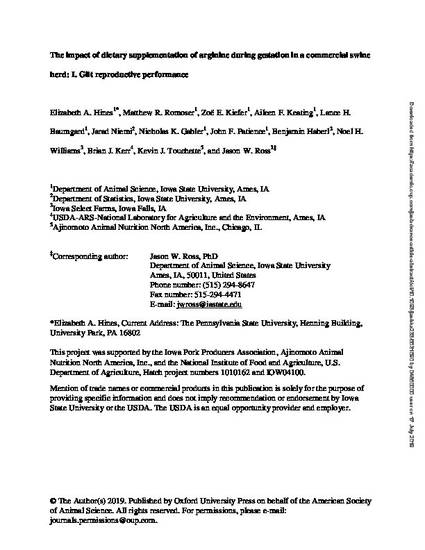
Supplemental Arg during gestation purportedly benefits fetal development. However, the benefits of a gestational Arg dietary strategy in commercial production are unclear. Therefore, objectives of this study examined Arg supplementation during different gestational stages and the effects on gilt reproductive performance. Pubertal gilts (n = 548) were allocated into four treatment groups: Control (n = 143; 0% supplemental Arg) or one of three supplemental Arg (1% as fed) treatments: from 15 to 45 d of gestation (n = 138; Early-Arg); from 15 d of gestation until farrowing (n = 139; Full-Arg); or from 85 d of gestation until farrowing (n = 128; Late-Arg). At farrowing, the number of total born (TB), born alive (BA), stillborn piglets (SB), mummified fetuses (MM), and individual piglet birth weights (BiWt) were recorded. The wean-to-estrus interval (WEI) and subsequent sow reproductive performance (to third parity) was also monitored. No significant effect of supplemental Arg during any part of P0 gestation was observed for TB, BA, SB, or MM (P ≥ 0.29). Offspring BiWt and variation among individual piglet birth weights did not differ (P = 0.42 and 0.89, respectively) among treatment groups. Following weaning, the WEI was similar among treatments (average of 8.0 d ± 0.8 d; P = 0.88). Litter performance over three parities revealed a decrease (P = 0.02) in BA for Early-Arg fed gilts compared to all other treatments, while TB and WEI were similar among treatments over three parities (P > 0.05). There was an increased proportion of sows with average size litters (12 to 16 TB) from the Full-Arg treatment sows (76.8% ± 3.7 %) as compared to Control (58.7% ± 4.2%; P = 0.01), however the proportion of sows with high (> 16 TB) and low (< 12 TB) litters was not different among treatments (P = 0.20). These results suggest that gestational Arg supplementation had a minimal impact on reproductive performance in first parity sows. These data underscore the complexity of AA supplementation and the need for continued research into understanding how and when utilizing a gestational dietary Arg strategy can optimize fetal development and sow performance.
Available at: http://works.bepress.com/aileen-keating/35/

This is a manuscript of an article published as Hines, Elizabeth A., Matthew R. Romoser, Zoë E. Kiefer, Aileen F. Keating, Lance H. Baumgard, Jarad Niemi, Nicholas K. Gabler et al. "The impact of dietary supplementation of arginine during gestation in a commercial swine herd: I. Gilt reproductive performance." Journal of animal science (2019). doi: 10.1093/jas/skz233.